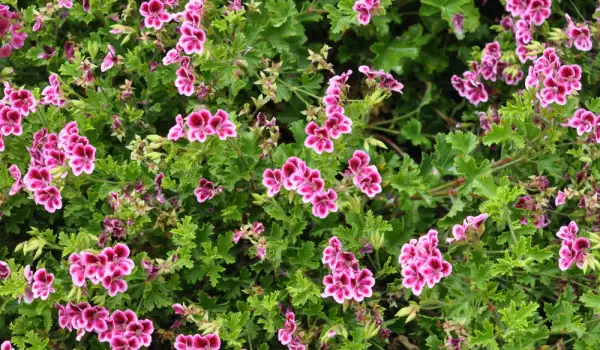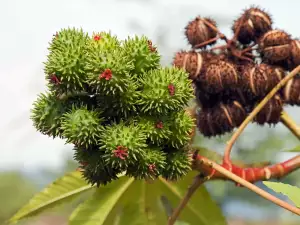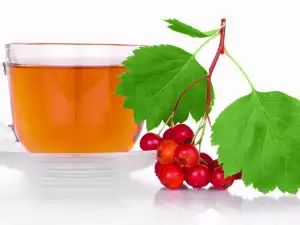Geranium is an evergreen subshrub with deeply slashed leaves and pink flowers with a very specific flavor. The essential oil is widely used in perfumery, cosmetics, canning industry and for the production of alcoholic beverages for a pleasant scent. Normally the leaves and upper parts of stems and flowers are used - mainly from the semi- bushes. It is a hybrid and is found wild.
Geranium is a perennial, evergreen subshrub in the Geraniaceae family. Geranium is cultivated to obtain the essential oil as an annual crop, and for decorative purposes. Its root system is highly branched, woody, fuzzy, penetrating deep into the soil, up to 15 to 60 cm and has erect stems, branched, with a height between 100-120 cm, and the branches of young and high ones are covered by glandular material.
Botanical Geranium is near geranium, and its administration is close to ordinary geraniums. It is native to South Africa, where it now lies in its natural habitats. It’s grown as an ornamental plant in many countries to cultivate essential oil - South and North Africa, Southern Europe and South and Central Asia. Relatively large areas are cultivated in Georgia, Armenia. It was rought to Europe in 1690 and in 1819 France for the first time extracted essential oil.
The French began to produce the oil for commercial purposes at the beginning of the XIX century, and today a significant proportion of the world's oil that comes from the island of Reunion (formerly Bourbon Island), which is a tropical island located in the southwest Indian Ocean.
Grown at home, Geranium is freshener for its fragrant essential oils and even more. Flower releases phytonicides that have detrimental effects on bacteria. The smell of Geranium it is not a favorite of moths, flies and mosquitoes, so in some areas it is called “fly chaser”. Traditionally, women have used it for making soaps, lotions, you put it in water which is used to wash with as a flavoring agent.
Chemical composition and nutrients of Geranium
The ground part of Geranium contains large amounts of polyphenols, essential oils, vitamin C and the precursor of vitamin A. To use, apply young leafy stems bearing fragrant leaves and flowers containing 0.1 - 0.3% essential oil (Herba Pelargonii rosei).
For extraction of essential oil 2 types of geranium are also used - headed and aromatic. Above ground rosettes of geranium contain 0, 25% essential oil, polyphenol substances and others.
Usually Geranium’s raw material is used fresh, because its flavor is lost and it greatly reduces the content of essential oil in Geranium. Geranium has substances with insulin action and causes a drop in piping sugar. In this case, self healing is not recommended.
Geranium essential oil is extracted by steam distillation. Substances in it are similar to those of the essential oil from roses, so it has a similar flavor. This oil is a common forger of real rose oil. Essential oil of geranium is known in the trade as "tereshe" and is a lightly- greenish fluid.
Storage of geranium

Geranium is used fresh, because drying herbs loses much of the flavor as well as lowers the content of essential oil.
Culinary use
Geranium is well known as one of the essential ingredients in loved jams, marmalades and especially those of quince or plum. Even our grandmothers used the unique flavor to excite the appetite.
Growers from around the world grow Geranium aromas for the stem and leaves, making it a favorite spice for sweet sauces. Sometimes, its juice is used as a substitute for vanilla in cakes. Typically one geranium petal is enough for one jar of compote. Men appreciate the merits of Geranium as it heps with barrels of wine and brandy. The brandy acquires great flavor put a bunch of geranium leaves in your boiling pot.
Benefits of Geranium
Geranium in the room, besides creating a pleasant aroma and atmosphere, has a beneficial effect on the nervous system - invigorates, refreshes, removes fatigue and tension. Along with the pleasant scent that it radiates, it releases substances that provide natural disinfection to the premises. These substances are called phytoncides and in relatively short time, they kill microbes and viruses in the air.
Folk medicine and herbalists have long used Geranium to improve digestion, treat persistent diarrhea, as a good astringent and for invigorating blood vessels means - particularly effective for persistent uterine bleeding.
Bulgarian folk medicine recommends geranium preparations for the treatment of diabetes in adults, heart disorders, high blood pressure, dry paroxysmal cough with flu and laryngitis in children. These products are excellent strengthening means after severe prolonged illness and help overcome the spring fatigue. In such cases, Geranium is applied internally.

Good local antimicrobial and anti-inflammatory action of Geranium allows external application of crushed leaves or juice from the plant in the form of washes and poultices. The effect is very good for skin inflammations, and difficult to heal festering wounds. For insomnia, nervous depression and heart disorders, treatment by inhalation. The scent of Geranium is cool and soft and helps sleep, so use it in the tub for bathing.
Traditional medicine with geranium
After illness and fatigue: 200 g liquid glucose or honey mixed with the juice of 3-4 lemons, finely grated with their dkin, 20 fresh, crushed leaves of Geranium and crushed almonds or 30 walnuts. The mixture is kept in a tightly closed container in a cool place. Take 1 tablespoon in the morning - 30 minutes before breakfast.
Against diabetes and high blood pressure, eat 2-3 fresh geranium or dried leaves 6-9 minutes before eating.
With a strong, dry, irritating coughs, apply 2-3 geranium leaves, 2-3 tablespoons basil, 2-3 chopped walnuts (with shells) that are cooked in 500 ml of water for 5 minutes. Drink a candy-sugar or honey potion, 3-4 times a day.






















